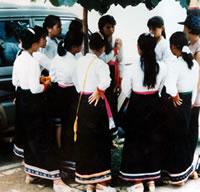Gender Equality in China
Gender relations generally improved over the last fifty years as women shed many of the shackles of an old patriarchal system with the help of the Constitution and legislation. Women entered into almost all walks of life and created one of the highest female employment rates in the world. Women accounted for 8% of the total work force in 1949, rising to 31% in 1978, and reaching 46% in 1995. Since the start of the economic reforms in 1978, however, women began to encounter increasing discrimination as the contradiction between gender equality, as provisioned by law, and the differential treatment in practice became more prevalent.
 Women
in China experience low political participation at all levels, especially at
the village and township level as a result of, among other things, gender based
discrimination and early retirement. Similarly, in the public sector, women
face more difficulties than men in gaining promotion as, for instance, they
are obliged to retire at age of 55, five years earlier than men. In many cases
women are laid off first by factories and often have to take work outside the
social protection of a regulated formal market. Limited employment opportunities
and pressure to send money back home can lead to risky occupations such as prostitution,
rates of which have increased dramatically over the last 20 years.Women currently
comprise 60-70 % of the agricultural labour force (Chinese Women’s Research
Handbook, 1995) as many men have left to seek employment in the cities. Even
though rural women shoulder much of the primary farm work, they are prevented
by traditional male-oriented cultural values from access to and control over
productive resources such as land, credit, technology, information and training.
The situation is compounded by the absence of adequate legal protection for
the rights of women to contract lands and other resources in rural areas.
Women
in China experience low political participation at all levels, especially at
the village and township level as a result of, among other things, gender based
discrimination and early retirement. Similarly, in the public sector, women
face more difficulties than men in gaining promotion as, for instance, they
are obliged to retire at age of 55, five years earlier than men. In many cases
women are laid off first by factories and often have to take work outside the
social protection of a regulated formal market. Limited employment opportunities
and pressure to send money back home can lead to risky occupations such as prostitution,
rates of which have increased dramatically over the last 20 years.Women currently
comprise 60-70 % of the agricultural labour force (Chinese Women’s Research
Handbook, 1995) as many men have left to seek employment in the cities. Even
though rural women shoulder much of the primary farm work, they are prevented
by traditional male-oriented cultural values from access to and control over
productive resources such as land, credit, technology, information and training.
The situation is compounded by the absence of adequate legal protection for
the rights of women to contract lands and other resources in rural areas.
Many women and girls still suffer disproportionately from low levels of health and malnutrition as a result of lack of access to health care and parental gender-based negligence. The maternal mortality ratio in rural areas was 2 to 3 times higher than that of urban areas in 1995. More tragically, data from the 1982 and 1990 censuses show under-five girl mortality rates higher than those of boys (Sun Jingzhi An Analysis of Population Trends in the 1980s, China Financial and Economic Publishing House, 1996). No data on mortality by sex is available for the 1990s. The preference for boys iscaused by social, cultural and economic factors but modern medical technologies that offer possibilities for reliable sex identification and safe abortion have clearly worsened the position for female foetuses.
Sex ratios at birth in China were basically normal in the 1960s and 1970s, except for some minor fluctuations. Since the 1980s, they have risen and moved rapidly further away from normal ratios.
Although the percentage of girls in primary schools has increased in recent years, rates drop off quickly at higher educational levels. For instance, while female students comprised 48% of primary school goers and 47% secondary school goers in 1999, they decreased to 40% for college attendance and only 32% for doctoral programmes. The female illiteracy rate has been consistently higher than that of men. About 70% of China’s 140 million estimated illiterates are women, concentrated in the economically underdeveloped rural regions.
HOME
| ABOUT
CHINA | RC
SYSTEM | THEMES
| WORKING
TOGETHER
PARTNERS
| GOALS
| EVENTS
| NEWS | CONTACT
US | SITE
MAP

